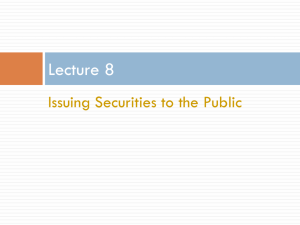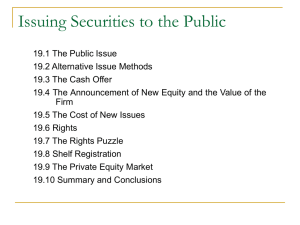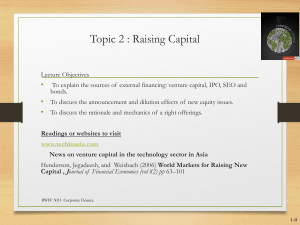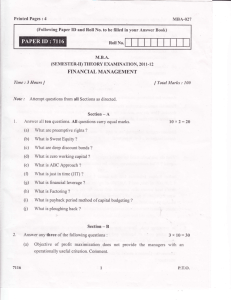registration statement
advertisement
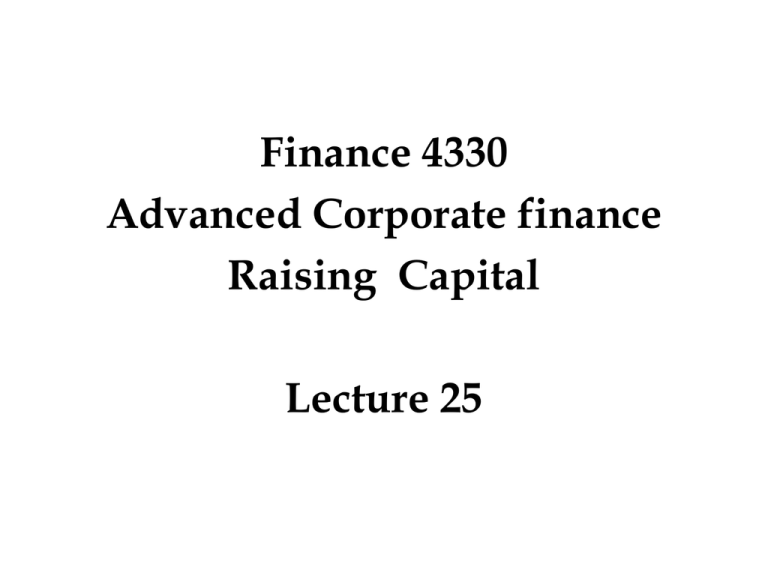
Finance 4330 Advanced Corporate finance Raising Capital Lecture 25 Key Concepts and Skills • Understand how securities are sold to the public and the role of investment bankers • Understand initial public offerings and the costs of going public • Understand the venture capital market and its role in financing new businesses Outline 1The Public Issue 2 Alternative Issue Methods 3 The Cash Offer 4 The Announcement of New Equity and the Value of the Firm 5 The Cost of New Issues 6 Rights 7 The Rights Puzzle 8 Shelf Registration 9 The Private Equity Market 1 The Public Issue • The Basic Procedure – Management gets the approval of the Board. – The firm prepares and files a registration statement with the SEC. – The SEC studies the registration statement during the waiting period. – The firm prepares and files an amended registration statement with the SEC. – If everything is OK with the SEC, a price is set and a full-fledged selling effort gets underway. The Process of a Public Offering Steps in Public Offering Time 1. Pre-underwriting conferences Several months 2. Registration statements 20-day waiting period 3. Pricing the issue Usually on the 20th day 4. Public offering and sale After the 20th day 5. Market stabilization 30 days after offering An Example of a Tombstone 2 Alternative Issue Methods • There are two kinds of public issues: – The general cash offer – The rights offer • Almost all debt is sold in general cash offerings. Table Table 3 The Cash Offer • There are three methods for issuing securities for cash: – Firm Commitment – Best Efforts – Dutch Auction • There are two methods for selecting an underwriter – Competitive – Negotiated Firm Commitment Underwriting • The issuing firm sells the entire issue to the underwriting syndicate. • The syndicate then resells the issue to the public. • The underwriter makes money on the spread between the price paid to the issuer and the price received from investors when the stock is sold. • The syndicate bears the risk of not being able to sell the entire issue for more than the cost. • This is the most common type of underwriting in the United States. Best Efforts Underwriting • Underwriter must make their “best effort” to sell the securities at an agreed-upon offering price. • The company bears the risk of the issue not being sold. • The offer may be pulled if there is not enough interest at the offer price. The company does not get the capital, and they have still incurred substantial flotation costs. • This type of underwriting is not as common as it used to be. Dutch Auction Underwriting • Underwriter accepts a series of bids that include number of shares and price per share. • The price that everyone pays is the highest price that will result in all shares being sold. • There is an incentive to bid high to make sure you get in on the auction but knowing that you will probably pay a lower price than you bid. • The Treasury has used Dutch auctions for years. • Google was the first large Dutch auction IPO. IPO Underpricing • May be difficult to price an IPO because there is not a current market price available. • Private companies tend to have more asymmetric information than companies that are already publicly traded. • Underwriters want to ensure that, on average, their clients earn a good return on IPOs. • Underpricing causes the issuer to “leave money on the table.” 4 The Announcement of New Equity and the Value of the Firm • The market value of existing equity drops on the announcement of a new issue of common stock. • Reasons include – Managerial Information Since the managers are the insiders, perhaps they are selling new stock because they think it is overpriced. – Debt Capacity If the market infers that the managers are issuing new equity to reduce their debt-equity ratio due to the specter of financial distress, the stock price will fall. – Falling Earnings 5 The Cost of New Issues 1. 2. 3. 4. 5. 6. Spread or underwriting discount Other direct expenses Indirect expenses Abnormal returns Underpricing Green Shoe Option The Costs of Equity Public Offerings Proceeds (in millions) 2 - 9.99 10 - 19.99 20 - 39.99 40 - 59.99 60 - 79.99 80 - 99.99 100 - 199.99 200 - 499.99 500 and up Direct Costs SEOs IPOs 2.88% 15.36% 8.81% 11.63% 7.24% 9.81% 6.20% 9.21% 5.81% 8.65% 5.56% 8.34% 5.00% 7.67% 4.26% 6.72% 3.64% 5.15% Underpricing IPOs 18.18% 10.02% 17.91% 29.57% 39.20% 45.36% 37.10% 17.72% 12.19% 6 Rights • If a preemptive right is contained in the firm’s articles of incorporation, the firm must offer any new issue of common stock first to existing shareholders. • This allows shareholders to maintain their percentage ownership if they so desire. Mechanics of Rights Offerings • The management of the firm must decide: – The exercise price (the price existing shareholders must pay for new shares). – How many rights will be required to purchase one new share of stock. • These rights have value: – Shareholders can either exercise their rights or sell their rights. Rights Offering Example • Popular Delusions, Inc. is proposing a rights offering. There are 200,000 shares outstanding trading at $25 each. There will be 10,000 new shares issued at a $20 subscription price. • What is the new market value of the firm? • What is the ex-rights price? • What is the value of a right? What is the new market value of the firm? $25 $20 $5,200,000 200,000 shares 10,000 shares share shares There are 200,000 outstanding shares at $25 each. There will be 10,000 new shares issued at a $20 subscription price. What Is the Ex-Rights Price? • There are 110,000 outstanding shares of a firm with a market value of $5,200,000. • Thus the value of an ex-rights share is: $5,200,000 = $24.7619 210,000 shares What Is the Ex-Rights Price? • Thus, the value of a right is: $0.2381 = $25 – $24.7619 7 The Rights Puzzle • Over 90% of new issues are underwritten, even though rights offerings are much cheaper. • A few explanations: – Underwriters increase the stock price. There is not much evidence for this, but it sounds good. – The underwriter provides a form of insurance to the issuing firm in a firm-commitment underwriting. – The proceeds from underwriting may be available sooner than the proceeds from a rights offering. • No single explanation is entirely convincing. 8 Shelf Registration • Permits a corporation to register an offering that it reasonably expects to sell within the next two years. • Not all companies are allowed shelf registration. • Qualifications include: – – – – The firm must be rated investment grade. They cannot have recently defaulted on debt. The market capitalization must be > $75 m. No recent SEC violations. 9 The Private Equity Market • The previous sections of this chapter assumed that a company is big enough, successful enough, and old enough to raise capital in the public equity market. • For start-up firms and firms in financial trouble, the public equity market is often not available. Private Placements • Private placements avoid the costly procedures associated with the registration requirements that are a part of public issues. • The SEC restricts private placement issues to no more than a couple of dozen knowledgeable investors, including institutions such as insurance companies and pension funds. • The biggest drawback is that the securities cannot be easily resold. Venture Capital • • The limited partnership is the dominant form of intermediation in this market. There are four types of suppliers of venture capital: 1. Old-line wealthy families 2. Private partnerships and corporations 3. Large industrial or financial corporations have established venture-capital subsidiaries. 4. Individuals, typically with incomes in excess of $100,000 and net worth over $1,000,000. Often these “angels” have substantial business experience and are able to tolerate high risks. Corporate Equity Security Offerings 17.7% Private Rule 144A placements 16.2% Private non-Rule 144A placements 66.1% Public equity offering Source: Jennifer E. Bethal and Erik R. Sirri, “Express Lane or Toll Booth in the Desert: The Sec of Framework for Securities Issuance,” Journal of Applied Corporate Finance (Spring 1998). Stages of Financing 1. 2. 3. 4. 5. 6. Seed-Money Stage Start-Up First-Round Financing Second-Round Financing Third-Round Financing Fourth-Round Financing
